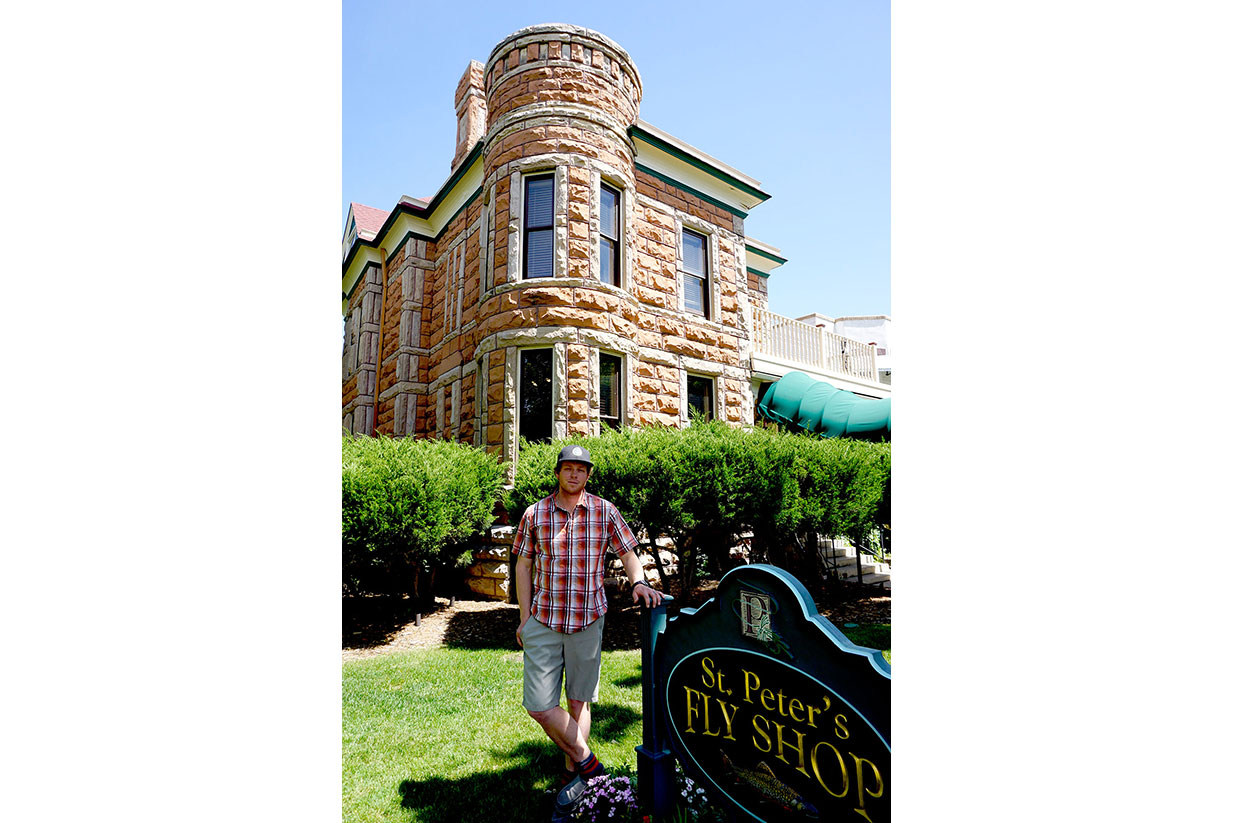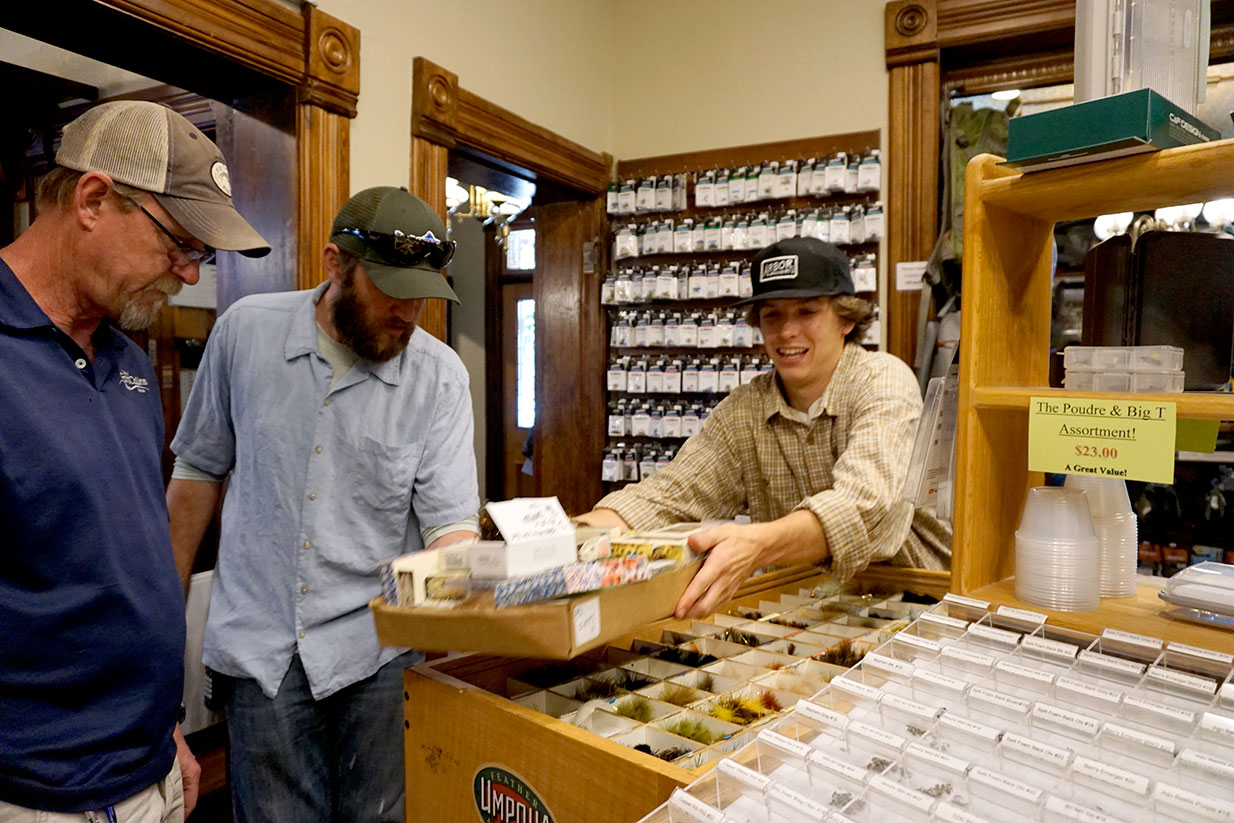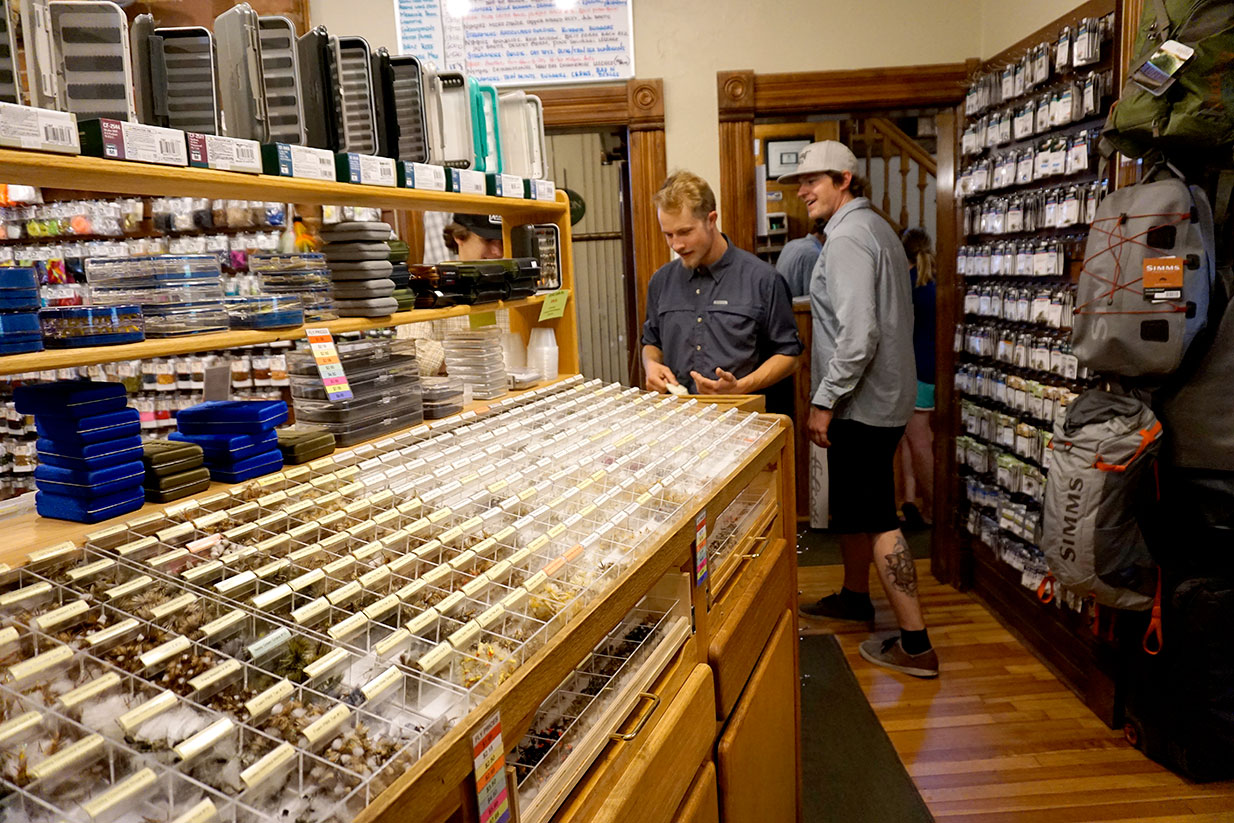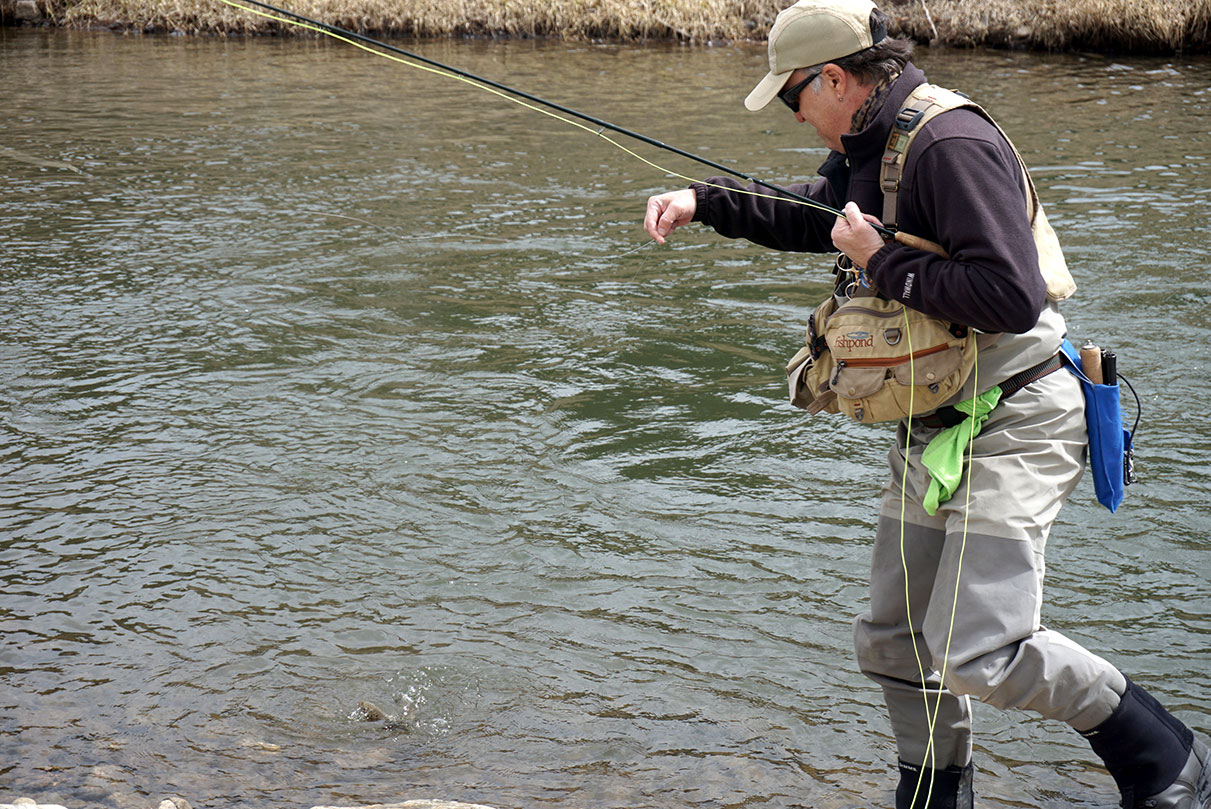Business on Cache la Poudre River Impacted by Fire, Flood
Ask any angler in Fort Collins, CO where to buy fly fishing supplies and you'll discover that St. Peter's Fly Shop is the only fly shop in town. It's a family-owned business based in a beautiful, historic brownstone near the old town section of Fort Collins. Grant Houx has been managing the business for 10 of the 24 years that St. Peter's has been open.
"My role here is to keep the doors open on a daily basis, which can mean a lot of things…from managing the staff, whether it's the retail staff or the guide staff, to managing products. Retail is a big part of our business, as well as the guide service. We have two shops: one on the south side of town and one here in old town," Houx explains. He plans guided fly fishing trips on local rivers, the Cache la Poudre River and the Big Thompson River.
The Cache la Poudre River, a congressionally-designated National Heritage Area and Wild and Scenic River, is directly east of Fort Collins. As Houx puts it, "The Cache la Poudre is our local river. For this shop in particular, it's the water that we utilize and respect. The way we look at it, the river is there as a resource and we're the ones who need to keep it up and keep it in good shape and condition so we can keep using it."
Houx stresses that "our business to a large degree operates on weather and conditions. With that being said, the two adjacent rivers here, to the south the Big Thompson, and to the north the Poudre, they're very different rivers. The Big Thompson is a dam river. It's a tailwater. The Poudre's a freestone. Now there are some releases on some creeks and they have somewhat control over the water on the Poudre, but not fully. And so freestone rivers [naturally] flood because there's no management of that system."
Tailwater is a term indicating a body of water downstream from a hydraulic structure, like a dam. Because dams are meant to retain water, not to overflow, water at capacity that breaches the retaining walls could endanger structures built below the dam, if those structures are built in the path of the flood plain.
A freestone stream is supplied by runoff and snowmelt, and is known for seasonal flows that swell as the snowpack melts. The Cache la Poudre, a freestone river, winds down the Poudre Canyon, which means greater fluctuations in water levels during extreme rain events because there is no dam to regulate flows.
Wildfires have also affected the Cache la Poudre National Heritage Area in recent years. Houx goes on to explain how the combination of the High Park fire in 2012 and the September flooding from 2013 affected his business. Fire and heavy rain events can adversely affect businesses and people that depend on the river, such as Houx' St. Peter's Fly Shop, but the particular combination of fire, then flood, had results that the layperson may not expect.
Wildfire
The High Park fire started June 9, 2012 and burned about 136 square miles in 33 days until its end on July 11, 2012. It was the most destructive fire in Larimer County, where it destroyed 259 homes and cabins, according to the Fort Collins City Council documentation titled High Park Emergency Stabilization Burned Area Report. The rainstorms that followed the fire in July 2012 only served to erode more soil and ash into the river, increasing the sediment in the water.
Laurence Hoess, director of the fly fishing school for the Colorado Mountain Club explains, "After fire has destroyed vegetation, there is nothing to hold the soil in place nor to absorb the precipitation from a heavy rain event. Silt and ash from burned trees are washed into the river which stresses the aquatic environment."
Other factors to consider as an impact on aquatic life after a fire include the reduced oxygen concentration in the water, increased trace elements suspended in ash from the fire, and lack of food for the fish. Houx emphasizes that "ash kills insects and fish eat insects."
Hoess explains, "Ash in the river impacts the aquatic insect life which the fish depend on as their primary food source. I assume that fish with greater fat stores would be better able to survive this kind of stress on their environment. Younger and smaller fish would have fewer fat stores so they are most likely to die first."
The direct impact of this fire on a fly shop such as Houx' is that during the natural disaster, his staff cannot run normal operations on the river, such as a guided fly fishing trip. He would have to depend on retail sales or pursue other means to keep the doors open. But aquatic life takes time to recover from an event such as this. How long would Houx have to wait until the fish had repopulated?
The High Park Emergency Stabilization Burned Area Report indicates that recovery from this fire would take longer than 3-5 years: "An emergency for water quality degradation was determined for the following reasons: Large sediment increases are expected. These increases will be of short term duration, recovering to pre-fire conditions over time with the worst impacts occurring over the next three to five years. …Immediate effects are the ash and sediment in the river, longer term changes to the water quality such as metals concentration and algae growth leading to taste and odor issues are anticipated. For example, Denver Water is still dealing with the Hayman fire more than a decade later."
Flood
However, one year and two months later, heavy rain expedited the cleansing of the river. The severe rain event from September 9-16, 2013 prompted the city of Fort Collins' Emergency Operations Center into action. A state of disaster was declared. This rainfall and subsequent flooding was the largest on the Cache la Poudre River since 1930, according to the City of Fort Collins Utilities.
Houx remembers the devastation of the flooding from September of 2013 with sympathy for the victims hardest hit. His shops didn't experience damage, but some people living to the east of Fort Collins lost a lot of property in that flood.
In regards to the Poudre Canyon, Houx describes, "Canyons are designed to withstand that type of flood. There are a few places where high waters damaged the road from erosion, but technically speaking, really the canyon held the water very well…I'm sensitive to people who do live to the east. It affected their lives, but as far as talking about the river goes, it was a blessing because the river had two and a half feet of ash in it from the fires from the previous year."
Hoess reflects, "We had a week of rain. Once the ground became saturated, the water had to go elsewhere. Typical runoff would fill the river with ash left from the fire, but the 2013 flood scoured the river clear of the ash."
Houx elaborates about the 2013 flooding, "As soon as it started to rain the river was full of water black with ash because the hills can't hold that; the riparian area is all destroyed. And then we had these floods and really, what could have potentially been a 10-year clean out of the river, or with drought even a 20-year cleanout, happened in a month. So in some ways the floods were a blessing, yet at the same time, yes, they affected our business at the time. But I can tell you it would have affected our business more if we still had two feet of ash in the river."
Future
Current challenges to a fly fishing shop on the Poudre include not only fire and flood, but getting minimal stream flows during the winter. Because the Poudre is not a tailwater, flows of the river can't be controlled, which limits the potential of economic growth due to sportsmanship tourism.
Houx describes his experience, "there is a lot of discussion about minimal flows in town. I believe that if we could get better minimal flows in town — so, enough water through town in winter — that we could have a sustained fishery. I look at many communities throughout Colorado, a lot of those being mountain towns…But if you think about Breckenridge or Keystone, or you think about Gunnison that goes through Crested Butte or Vail with Eagle Creek or Roaring Fork Valley that has Aspen and the tailwater rivers the Fryingpan and the Taylor, these rivers…allow for a lot of economic drive through fishing or through the [towns'] outdoor outlook. I think there's a draw to it. You can see the amount of money that sportsmen bring in to towns, whether you're talking about our guide service or people eating dinner or staying at hotels."
"A fishery is a place where fish can prosper and anglers can go to catch good sized fish. Without minimal flows, you can't establish a fishery and without the fishery, you can't increase an economic impact of fly fishing in downtown Fort Collins," explains fly fishing instructor Hoess.
St. Peter's Fly Shop is a community oriented store that feels like family when you walk in. Houx cultivates that family-style culture to sustain business and keep him motivated through hard times after natural disasters. His ideals for the future of St. Peter's center around his community:
"We just hope to grow with our community. You know our community's growing and the front range is growing…I think it's important that we are familiar with our resources because [a concern] with growth of something like fly fishing or the front range is the shrinking of resources for other people. So how do we make sure our resources are being taken care of and where are the places we're going to put fly fishermen? I hope we can continue to work on that…with agencies and conservancy groups that have a heavy focus on that. [I hope] we can continue to have places for people to fly fish so I can keep going fishing, you know? So with St. Peter's, we're really a community oriented type shop and I keep saying that because that's…who keeps our doors open."
Wildfires, high waters, and concerns for limited resources are some of the challenges faced by St. Peter's Fly Shop and other businesses based on their local rivers. Here's to a community that comes together to support each other after disaster and stay interested and involved in what happens to their water supply.




